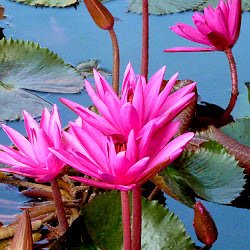Water lily, (family Nymphaeaceae), any of 58 species in 6 genera of freshwater plants native to the temperate and tropical parts of the world. Most species of water lilies have rounded, variously notched, waxy-coated leaves on long stalks that contain many air spaces and float in quiet freshwater habitats. The stalks arise from thick, fleshy, creeping underwater stems that are buried in the mud. The showy, fragrant, solitary flowers are borne at or above the water surface on long stalks that are attached to the underground stems. Each cuplike flower has a spiral arrangement of its numerous petals.
Water lily, (family Nymphaeaceae), any of 58 species in 6 genera of freshwater plants native to the temperate and tropical parts of the world. Most species of water lilies have rounded, variously notched, waxy-coated leaves on long stalks that contain many air spaces and float in quiet freshwater habitats. The stalks arise from thick, fleshy, creeping underwater stems that are buried in the mud. The showy, fragrant, solitary flowers are borne at or above the water surface on long stalks that are attached to the underground stems. Each cuplike flower has a spiral arrangement of its numerous petals.
The genus Nymphaea makes up the water lilies proper, or water nymphs, with 46 species. The common North American white water lily, or pond lily, is Nymphaea odorata. The European white water lily is N. alba. Both species have reddish leaves when young and large fragrant flowers. The leaf blades of N. alba have a deep, narrow notch. Other species of Nymphaea have pink, yellow, red, or blue flowers; many kinds are of hybrid origin. The lotus of ancient Egyptian art was usually the blue lotus (N. caerulea). The Egyptian lotus, N. lotus, has toothed leaves and long stalks that rise above the water’s surface to support white flowers that bloom at night and stay open until midday.
The genus Nuphar, with about 10 species distributed throughout the Northern Hemisphere, includes the common yellow water lily, cow lily, or spatterdock (Nuphar advena) of eastern North America. The yellow water lily has submerged leaves that are thin and translucent and leathery floating leaves.
The largest water lilies are those of the tropical South American genus Victoria, comprising two species of giant water lilies. The leaf margins of both the Amazon, or royal, water lily (V. amazonica, formerly V. regia) and the Santa Cruz water lily (V. cruziana) have upturned edges, giving each thickly veined leaf the appearance of a large, shallow pan 60 to 180 cm (about 2 to 6 feet) across and accounting for its common name, water platter. The fragrant flowers of Victoria have 50 or more petals and are 18 to 46 cm (about 7 to 18 inches) wide. They open white toward evening and shade to pink or reddish two days later before they wither, to be replaced by a large berrylike fruit.
Water lilies provide food for fish and wildlife but sometimes cause drainage problems because of their rapid growth. Many varieties have been developed for ornamental use in garden pools and conservatories. Two aquatic families related to the water lilies are the water shields and the fanworts, making up the family Cabombaceae. Nymphaeaceae and Cabombaceae are members of the water lily order, Nymphaeales.
Hi! I am a robot. I just upvoted you! I found similar content that readers might be interested in:
https://www.britannica.com/plant/water-lily